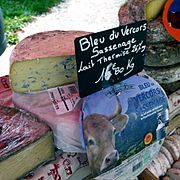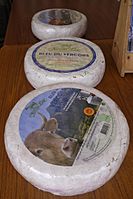Bleu du Vercors-Sassenage facts for kids
Bleu du Vercors-Sassenage is a delicious and mild blue cheese from France. It's made from cow's milk and has a natural rind. This special cheese was first created by monks way back in the 14th century!
The cheese is made in a region of France called Dauphiné. It has a special protected status called "Appellation d'Origine Contrôlée" (AOC) since 1998. This means it must follow strict rules to be called Bleu du Vercors-Sassenage.
Contents
What is Bleu du Vercors-Sassenage Cheese?
Bleu du Vercors-Sassenage is a type of blue cheese. This means it has blue or green molds inside that give it a unique flavor and look. It's known for being mild, which means it's not too strong or sharp. The milk used to make it is pasteurized, which means it has been heated to kill any harmful germs.
Where Does This Cheese Come From?
This cheese has a long history! It was first made by monks in the Rhône-Alpes region of France during the 14th century. That's over 600 years ago! Today, it's still made in the same general area, specifically in the Dauphiné region.
How Is Bleu du Vercors-Sassenage Made?
To make this cheese, milk from specific types of cows must be used. These cows are the Montbéliard, Abondance, or Villard breeds. The cheese is made without being pressed or cooked. It also contains a special mold called Penicillium roqueforti, which is what gives it its blue veins and distinct taste.
Why Is This Cheese Special?
The "Appellation d'Origine Contrôlée" (AOC) status makes this cheese very special. It's like a guarantee that the cheese is authentic and made according to traditional methods in its specific region. This helps protect its quality and unique character.
A King's Favorite Cheese
Even kings enjoyed this cheese! In a big French dictionary from the 19th century, it's mentioned that King Francis I really loved Bleu du Vercors-Sassenage. He was a king of France in the 16th century, showing just how long this cheese has been appreciated!
See also
 In Spanish: Bleu du Vercors-Sassenage para niños
In Spanish: Bleu du Vercors-Sassenage para niños




